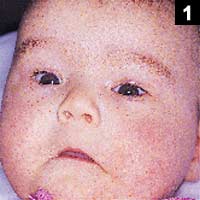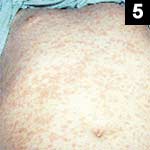An 8-month-old girl with rash
An 8-month-old female is admitted to the hospital for the evaluation and observation of a febrile illness with a rash and decreased oral intake. The history of this illness began five days earlier with decreased oral intake, fever and a rash that began on her face. By the time she was seen that day, the rash was generally distributed all over, including her arms, legs and trunk. The rash was described as maculopapular with some petechiae, but there were no other abnormal findings or complaints, i.e. cough, vomiting or diarrhea. At that time, she was diagnosed with a viral exanthem and told to return if she worsened. On the day of admission, the parents brought the patient back to the urgent-care clinic, seeing a different provider, because she did not seem to be getting better, and her oral intake had been decreasing.


Examination revealed an afebrile, alert, active 8-month-old female whose vital signs were normal. Her skin was covered with a maculopapular rash mixed with petechiae (figures 1 and 2). The rest of her exam was normal. A complete blood count showed a WBC count of 9,200 with 12% granulocytes, 1% bands and 76% lymphocytes. She had a normal hemoglobin and hematocrit and a platelet count of 303,000.
What’s your diagnosis?
- Meningococcemia
- Viral exanthem
- Dengue fever
- Measles
Answer

The answer in this case is B, viral exanthem. Of course, the cutaneous manifestations of dengue and measles are also viral exanthems. However, the answer in this case is meant to represent the all-too-common situation of being faced with a febrile child with a petechial rash, who otherwise appears only mildly ill. In this case, a concerned provider, because of ongoing poor oral intake, admitted the child to the hospital for observation several days after the onset. However, I doubt that she would have been admitted had it not been for the petechial rash. And, of course, the reason for this is the looming fear of missing an evolving case of potentially fatal meningococcemia. The factors against meningococcemia in this case were the apparent resolution of fever by the day of admission, lack of progression of the rash (figure 3, meningococcemia with purpura) and the general well being of the patient supported by a normal CBC. However, when an experienced provider gets that creepy feeling about a patient, regardless of the above, it is usually best to utilize a brief period of observation in the hospital to be sure. How much further the patient is investigated would depend on the situation.

One should use some common sense when evaluating these patients and take into account some good studies on this subject. I have addressed this issue in past columns, but as we move into the winter months, and these cases increase in frequency, perhaps it is time to take another look. There is marked variation in the approach to febrile patients with petechiae, depending on the clinical setting and the individual experience (Nelson DG, Leake J, Bradley J and Kuppermann N. Evaluation of febrile children with petechial rashes: is there consensus among pediatricians? Pediatr Infect Dis J. 1998;17[12]:1135-1140). One retrospective study (Greenes DS and Harper MB. Low risk of bacteremia in febrile children with recognizable viral syndromes. Pediatr Infect Dis J. 1999; 18[3]:258-261) suggests that when the child has a recognizable viral illness such as croup, stomatitis, bronchitis, etc., there is a very low risk (0%-0.2%) of bacteremia. The patient presented here had a nonspecific febrile illness with a petechial rash, but otherwise appeared only mildly ill. In the February 2001 issue of Infectious Diseases in Children, I presented a case of known adenovirus conjunctivitis infection with a petechial rash. As in the case presented in this issue, when I first saw that patient, I had the advantage of knowing the course over the last few days, and that the petechiae had not changed, nor had the severity of the child’s illness. I still worry about meningococcemia, especially when these patients first present, but when the lab tests are normal and the patient has a nontoxic, recognizable viral illness-appearance, I’m not likely to start antibiotics or admit to the hospital, even with petechiae, especially upper body or stress-related petechiae. Sometimes there is other supporting evidence of a viral etiology, such as other members of the family with the same “viral” condition.
I don’t want to come across sounding cavalier about this very important subject, but I think there is a balance between appropriate concern and common clinical sense that we hopefully reach as we get more experienced. You would think that by now, at my age, I would be in that comfort zone. However, I still often find myself questioning my ability when faced with a patient like this. It’s easy to write about this patient, but not so easy to have her in front of you, with “all her marbles” possibly riding on what you decide to do next. Nobody ever said that medicine was easy. I think that’s especially true of pediatrics. By necessity, practitioners of pediatrics become expert observers, because many of our patients cannot verbally communicate, and the history is frequently the interpretation of a distraught parent, oftentimes making the child sound sicker than they really are. The art of medicine is knowing how to discern the difference when you see it. Passing boards is good, but this art is what we really spend three years trying to teach our residents. Our patient, now 2 years old, went home the next day, and continues to do well.
Dengue fever

Regarding the other choices, dengue fever is caused by one of the 4-dengue viruses, which are arboviruses in the Flaviviridae family, spread by the mosquito. It results in a febrile, flu-like illness with marked arthralgias and myalgias (breakbone fever). A petechial rash usually reflects evidence of capillary fragility and/or thrombocytopenia (figure 4, dengue hemorrhagic fever). Measles is obviously a febrile disease with an exanthem, but petechiae are not typical. Rather, one sees a “morbilliform” rash, beginning as discrete maculopapular lesions that quickly become confluent as it progresses (figure 5). Morbilliform comes from the Latin words for “measles-shape” or “measles-like.” The background of the word “measles” appears to be in part from the Latin word “misellus” meaning wretch or miserable. In addition to fever and a rash, the patient is “miserable” with cough, coryza, conjunctivitis, and can lead to encephalitis with severe neurologic damage or death. The treatment for both dengue and measles is supportive. However, with measles, if vitamin A deficiency is suspected, then supplemental vitamin A should be given. This has more implication in underdeveloped countries, but malnutrition also exists in certain parts of our country as well. It’s certainly worth thinking about. I would refer you to the Red Book for more details of vitamin A treatment for measles. Prevention is with vaccine for measles and mosquito avoidance for dengue.
To read more about these, and other viral diseases and the rashes they cause, I highly recommend the book, Mucocutaneous Manifestations of Viral Diseases, by Stephen K. Tyring, 2002, published by Marcel Dekker Inc. Its comprehensive description of diseases is very nicely complimented by an abundance of color pictures. I might point out that my associate, Mike Weir and his daughter, Tracey Weir, MD, co-authored several of the chapters, including the one on dengue fever.
What’s Your Diagnosis? is a monthly case study featured in Infectious Diseases in Children, with treatment information and discussion to follow.
